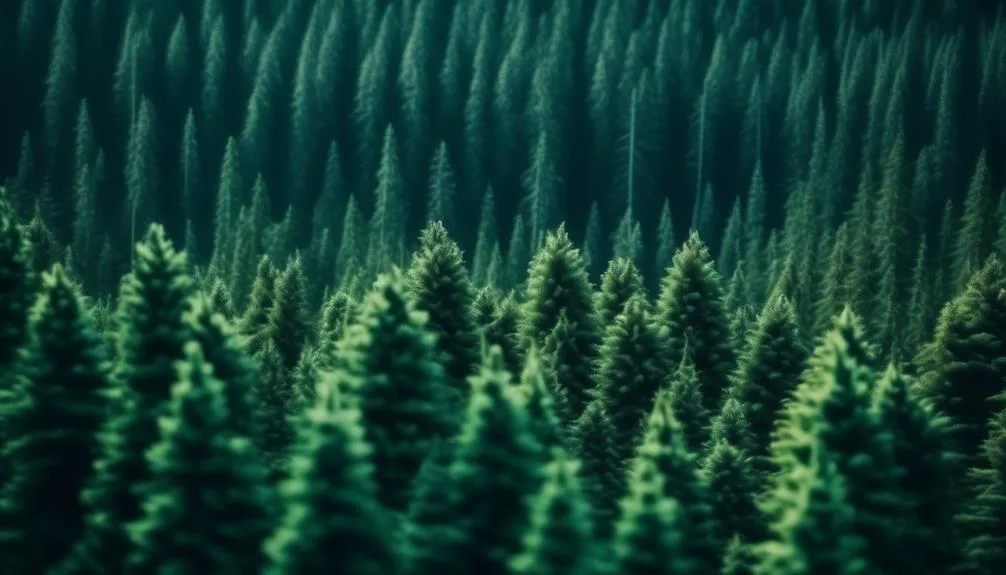Have you ever thought about whether spruce trees are truly evergreen? Despite their name and appearance, the classification of spruce trees as evergreen may not be as clear-cut.
Understanding the factors behind their seasonal characteristics can shed light on this. Let's explore the mystery behind spruce trees' perennial greenery and uncover the truth about their evergreen status.
Spruce Tree Characteristics
Spruce trees are known for their conical shape and needle-like leaves, making them a distinctive and recognizable part of many landscapes. These evergreen tree species belong to the genus Picea and are commonly found in northern temperate and boreal (taiga) regions.
Their appearance is characterized by their pyramid-like crown, which gives them a majestic and elegant presence in forests and gardens. The sharp, pointed needles of spruce trees are attached individually to the branches, and their color can range from bluish-green to dark green, adding to their visual appeal.
The unique appearance of spruce trees not only enhances the natural beauty of their surroundings but also provides habitat and food for various wildlife species, making them an essential component of diverse ecosystems.
Seasonal Foliage of Spruce Trees
With the changing seasons, the foliage of spruce trees undergoes a remarkable transformation, adding a dynamic element to their already striking appearance.
- Seasonal Changes:
- In spring, new growth emerges in the form of vibrant, light green needles, creating a fresh and lush canopy.
- Throughout summer, the needles maintain their characteristic hue, providing a cooling and calming presence in the landscape.
- As fall approaches, the needles transition to a rich, deep green, intensifying the tree's visual impact and preparing for the colder months ahead.
Tree Adaptations:
- The evergreen nature of spruce trees enables them to retain their needles throughout the year, ensuring a continuous presence of greenery even in winter.
- Their needle-like foliage minimizes water loss, allowing them to thrive in various climates and conditions.
These adaptations make spruce trees resilient and visually captivating across all seasons.
Evergreen or Deciduous?
Exhibiting an impressive resilience, spruce trees maintain their lush green foliage year-round, showcasing their evergreen nature and contributing to the landscape's enduring beauty. As an evergreen conifer, spruce trees retain their needles throughout the year, unlike deciduous trees that undergo seasonal shedding. This unique characteristic allows them to provide constant greenery and act as a steadfast presence in various ecosystems.
The evergreen nature of spruce trees is an adaptation to harsh weather conditions, enabling them to efficiently photosynthesize and conserve water during winter months. Their ability to retain foliage year-round not only adds visual appeal but also provides habitat and food for wildlife, making them a vital component of diverse ecosystems.
Factors Affecting Spruce Tree Foliage
Understanding the environmental factors that impact the foliage of spruce trees is essential for maintaining their health and vibrancy throughout the year. Several factors can influence the growth patterns and overall appearance of spruce tree foliage:
- Climate: The climate, including temperature and precipitation, directly affects the health and growth of spruce trees. Cold temperatures can cause desiccation, leading to browning or loss of needles. Excessive moisture can contribute to fungal diseases that affect the foliage.
- Soil Conditions: The type and quality of soil play a crucial role in the health of spruce trees. Well-drained, acidic soils are ideal for spruce trees. Compacted or poorly drained soils can hinder root development and nutrient uptake, impacting foliage health.
- Light Exposure: Adequate sunlight is essential for the optimal growth and appearance of spruce tree foliage. Insufficient light can lead to sparse foliage and poor growth patterns.
Understanding and managing these factors can help ensure healthy and vibrant foliage on spruce trees.
Conclusion on Spruce Tree Evergreen Status
Spruce trees maintain their evergreen status throughout the year, providing a consistent and enduring presence in the landscape. This has significant implications for the environment, as their year-round foliage offers continuous benefits such as providing shelter for wildlife, preventing soil erosion, and contributing to the overall aesthetic appeal of natural surroundings.
The environmental impact of spruce trees being evergreen also extends to their ability to purify the air by absorbing pollutants and releasing oxygen, thereby improving air quality. Additionally, their constant foliage means they can continue to perform photosynthesis even during the winter months, helping to mitigate the effects of climate change by sequestering carbon dioxide.
Conclusion
In essence, spruce trees stand as resilient symbols of perpetual greenery. They adapt to varying conditions while maintaining their evergreen nature. Their enduring foliage serves as a testament to nature's steadfastness.

My interest in trees started when I first saw the giant sequoias in Yosemite.
I was a teenager then, and I remember thinking, “I need to learn more about this.”
That moment stuck with me.
A few years later, I went on to study forestry at Michigan Tech.
Since graduating, I’ve worked in a mix of hands-on tree care and community education.
I’ve spent over ten years helping people understand how to plant, maintain, and protect the trees in their neighborhoods.
I don’t see trees as just part of the landscape.
They are living things that make a real difference in our daily lives.
